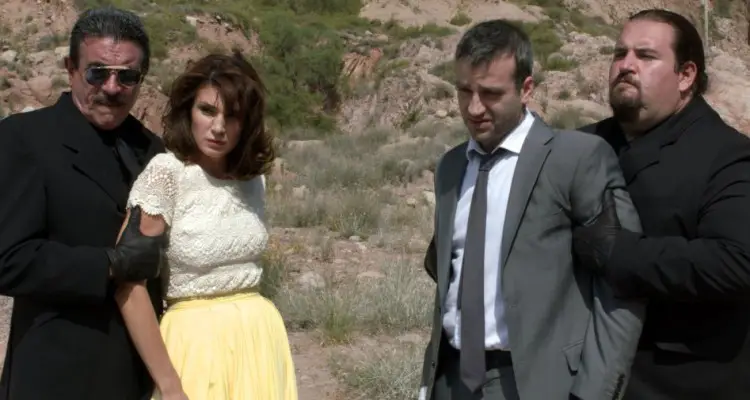TO FOOL A THIEF Wines and Dines with Charm

David Kahen-Kashi is a writer living in Washington, D.C. and…
This movie is screened during the Spanish Film Festival in Australia, taking place all May.
In Ariel Winograd’s To Fool A Thief, we’re often reminded to think upon the kind of screwball comedies that made romance the immaterial ideal that critics so often found unbearable for its overtly fictitious realities – It Happened One Night, My Man Godfrey, The Great Ziegfeld and on and on the list goes. It’s not surprising during the course that Winograd’s film should reprise these classical thematic structures, but it’s presented in a fashion which is ultimately a distraction from the main action. A heightened hodgepodge of cinematic cues that come in the form of parodies are run straight into the ground. To Fool a Thief plays itself seriously, which in the best case scenarios is a very good choice. However, Winograd after his fast pitched opening, that involves a well worn heist from a museum that compounds into several series of double crosses, his film To Fool a Thief loses momentum.
The film then continues to impress upon the audience how learned it is. Winograd and the writer of the film, Adrian Garelik, seem to know what their going for, but can’t seem to move past these cinematic references that later take a central role in the film even if they’re not meant to be so. From obligatory nods to James Bond to Roman Holiday, To Fool a Thief doesn’t merely contain a plot so much as feel as if its well crafted fan fiction about film. What if Audrey Hepburn dropped into Sean Connery’s sinewy universe where villainous bald men begin to look like their pet bald cats?
Argentinian Hustle
To Fool a Thief begins inauspiciously enough with that aforementioned heist. Sebastian (Daniel Hendler), a debonaire, stout and agile man with a taste for mid-level luxury sedans, attempts to steal a priceless mask from a museum with an unusually high level of security personnel and an even more peculiarly outdated alarm system. Sebastian meets a beguiling young employee of the museum named Natalia (Valeria Bertuccelli) and charms her until he can swipe her keycard and gain access the the museum after hours.

In the swirling haze of the opening prologue this mask changes hands until Natalia escapes with Sebastian’s score. Fuming and wishing to seek his well earned reprisal against Natalia, Sebastian shuttles of to the city of Mendoza, Argentina where he finds out that Natalia is in the midst of another scheme to swindle the prominent wine collector Segundo Basile (Juan Leyrado) out of a rare bottle of wine, a Chateau Verdoux 1845, favored by Napoleon III. Basile becomes aware of this plan to swindle him and turns the tables on Sebastian and Natalie. The thieves are given 72 hours to steal the real bottle of Chateau Verdoux from a high-security bank or risk losing more than they bargained for.
Veni Vino Vici
What To Fool a Thief ultimately boils down to are the exasperating callbacks to other films while sustaining a little heist narrative that on its own, and with the stylistic elements of 60’s fashion, would have been serviceable enough. What Winograd’s film eventually sustains itself on, and rightly, is the roiling chemistry between the two leads. Valeria Bertuccelli has the pouty charm and wit of Audrey Hepburn and the steely magnetism of Julianna Margulies. Daniel Hendler’s, while seemingly ill fit to slip into the role of a seasoned robber on occasion, carries his performance with an endless series of porridge faced grimaces. While it seems as if the filmmakers have leaned on these two in the attempt to craft a genuinely appealing element of mismatched chemistry in a will they or won’t they romance, the comic elements are outsourced to a litany of overcooked character actors; whose balance between borderline slapstick comedy and maintaining a semblance of solemnity are often undermining what would seem like a middling affair.

It’s not as if Winograd’s direction is entirely at fault. Wine heists don’t make particularly compelling cinema, with Year of the Comet offering a smattering of what can go absolutely wrong with the kind of henpecked dramatic offerings that this narrow field of interest can offer. However, exasperating as it is, Gaitan’s script is filled with a alluring sort of wit and whimsy, giving Sebastian and Natalia room to reenact scenarios from Bonnie and Clyde to Rififi. The film is elevated by a smart score by Dario Eskenazi that retains little of the brassy work of John Barry, although it can also at times seem contrived and down right hokey with awkward passages of rap influenced cues.
To Catch A Thief
To Fool a Thief conclusively is a pleasant film. Most of the performances range from comic to one note and don’t retain any of the la-di-da notions that were present in a film like Year of the Comet. But it’s essentially a small story based on archetypes. While fundamentally fun on a generally visceral level, with smooth, stylish cinematography and respectable production design, To Fool a Thief relies on its filmic knowledge to carry it through the day rather than put it to use as Quentin Tarantino often does with gumption. Caught between telling the audience about movies which are far richer in quality rather than worrying about the form of the film being made leads to rough patches within the story that often halt to remind of something relating to the matter.

Much further into the film, Natalia sits at a table while the antagonists begin to interrogate her and in full view is a shirt which the title North by Northwest is emblazoned upon it. In that film Roger Thornhill (Carey Grant) ends up hanging perilously off Mount Rushmore in an attempt to evade spies after him. To Fool a Thief doesn’t contain the natural delights that Alfred Hitchc*ck’s film contained, nor does the acting come close to the effortless and captivating ways Grant managed to command with his screen presence. But it’s agreeable enough, if only for the mildly informative explanation of the drinking habits of 19th century rulers.
Does content like this matter to you?
Become a Member and support film journalism. Unlock access to all of Film Inquiry`s great articles. Join a community of like-minded readers who are passionate about cinema - get access to our private members Network, give back to independent filmmakers, and more.
David Kahen-Kashi is a writer living in Washington, D.C. and studies Literature at American University. He is also the Arts & Entertainment Editor at The Eagle and a writer at Movie Rehab. Mr. Kahen toils away at many things, most of which involve sitting in darkened theaters with strange humanoids.













